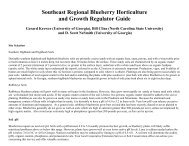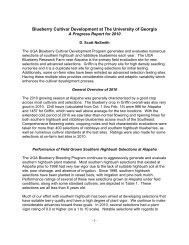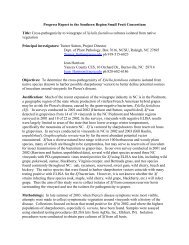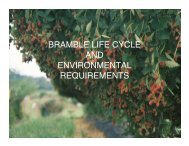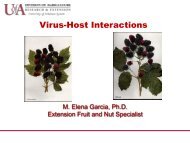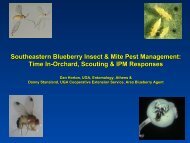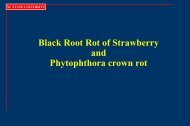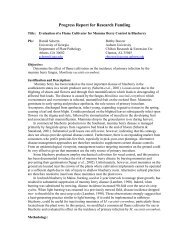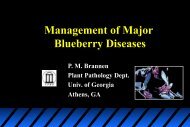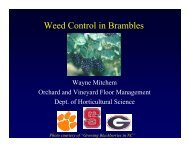Causal organism. <strong>The</strong> Xylella fastidiosa bacterium is pathogenic on numerous plantspecies. In addition, it is known to inhabit many host plants without causing diseasesymptoms; among these are various grasses and herbaceous weeds which are generallyfound throughout the blueberry production region <strong>of</strong> Georgia; native blueberries alsolikely harbor the bacterium. <strong>The</strong>refore, there is generally a bacterial reservoir which isreadily available for infection.Little is known about the specific Xylella fastidiosa strain found in blueberry. Thisbacterium may be genetically identical to the subspecies causing Pierce’s disease <strong>of</strong> grapeor the one causing phony peach, major Xyllella-incited diseases which also occur inGeorgia, or it may distinct from both. As in other Xylella-incited diseases, it is assumedthat the bacterium blocks xylem vessels, thereby preventing water and nutrient flow fromthe soil throughout the plant. This bacterium only survives in plant xylem or within theinsects which vector it. In general, Xylella diseases are more prevalent in warmerenvironments; this is related in part to the fact that the insect vectors, primarilysharpshooters, survive better in warmer environments, but the bacterium also overwintersmore successfully within host plants in warmer climates. Though it is speculation at thispoint, the increase in bacterial leaf scorch in Georgia may be at least partially related towarmer winters which may have aided survival <strong>of</strong> vectors and the bacterium. Withoutregard, South Georgia and Florida provide ideal environments for both the bacterium andthe vectors to survive.To date, the disease has been an obviously observed field problem <strong>of</strong> southern highbushblueberry varieties only. It is not known whether this disease is also causing problems inrabbiteye varieties. <strong>The</strong> bacterium can in fact colonize rabbiteye plants, but whether ornot it results in chronic or acute disease has not been determined for rabbiteye varieties.However, there is no doubt at this point that the disease is causing chronic and acutelosses in southern highbush varieties.Disease cycle and causal conditions. <strong>The</strong> disease cycle <strong>of</strong> this bacterium in grape,peach, and plum is well known, and it is likely the same in blueberry. Infected hostsserve as reservoirs and overwintering sites <strong>of</strong> the bacterium. In the spring and earlysummer, insect vectors, sharpshooters and spittle bugs, transmit the bacterium throughfeeding on infected plant tissues and subsequent feeding on healthy plants. In othersystems, the glassy-winged sharpshooter, Homalodisca coagulata, is the most importantvector. <strong>The</strong> glassy-winged sharpshooter can be found abundantly in south Georgia andFlorida, where it is known to be the major vector <strong>of</strong> Xylella in peach, while alsopreventing production <strong>of</strong> European wine grapes. Once the insect has acquired thebacterium, it is transmitted to a new plant as the insect injects the bacterium into thexylem (the conductive tissues which transmit water and nutrients from the roots to theother plant tissues) during feeding. This bacterial species is unique in that it is limited tolife in the plant xylem. Movement <strong>of</strong> the bacterium occurs throughout the plant xylemsystem. At some point, bacteria form colonies, and through a combination <strong>of</strong> tyloses,gumming and bacterial exudate production, the xylem is clogged. In time, clogging <strong>of</strong>vessels reaches a point at which individual stems or whole plants will no longer be able to
carry sufficient water and nutrients to support life. At this point symptoms develop, andeventually the plant will die. Plant death can be relatively rapid, but in general, symptomdevelopment starts in one year and continues through at least a second season beforeplant death.Though it has not been proven, it is assumed that this bacterium can be transmittedthrough propagation from infected plants. If so, then this is particularly troubling, sincemassive numbers <strong>of</strong> plants can be disseminated rapidly to expand the epidemic. <strong>The</strong>combination <strong>of</strong> propagation and insect vectoring could cause rapid spread throughout theentire region. However, it is likely that infected plants would not be utilized forpropagation very <strong>of</strong>ten, since they would show disease symptoms. In addition,propagated, infected plants may be killed rapidly in the nursery, therefore preventingadditional spread. This raises many questions and much research is needed to address thespecific question <strong>of</strong> propagative spread through cuttings.Root grafting may also serve as a potential transmission mechanism. In high-densitybeds, this may be particularly important as a means <strong>of</strong> spread, but again, there has beenno research conducted to date to support this premise.Symptoms. <strong>The</strong> initial symptom is a marginal leaf scorch (burn), which unfortunately issimilar to that observed with extreme drought, fertilizer salt burn, or root rots (Figure2). Sometimes, the scorched leaf area is bordered by a darker band between the healthyand scorched tissue. This leaf symptom can be uniformly distributed throughout the plant,but in the early stages, scorching may be limited to individual stems or perhaps one side<strong>of</strong> the plant – indicating that only a partial xylem blockage has occurred which may belimited to one cane or one stem. Spring growth is characterized by twigs <strong>of</strong> very thindiameter. Eventually, leaves abscise (drop), and young twigs/stems may take on a yellowappearance (Figures 3-4). After leaf drop, the plant eventually dies (Figure 5). Often,where a plant has died from bacterial leaf scorch, a neighboring plant will showsymptoms the following year.<strong>The</strong> most unique symptom <strong>of</strong> bacterial leaf scorch is actually observed once leaves havedropped – the yellowed stems and twigs. <strong>The</strong> plant can drop virtually all leaves and yetremain otherwise healthy in appearance; the stems and root systems appear sound, andvascular discoloration is not generally observed. Once the leaves have dropped from theplant, the plant takes on a skeleton-like appearance. Dieback is also not generallyassociated with this disease in the early stages; <strong>of</strong> course, the final result is plant death,and at that point it is not possible to diagnose the cause <strong>of</strong> death.



